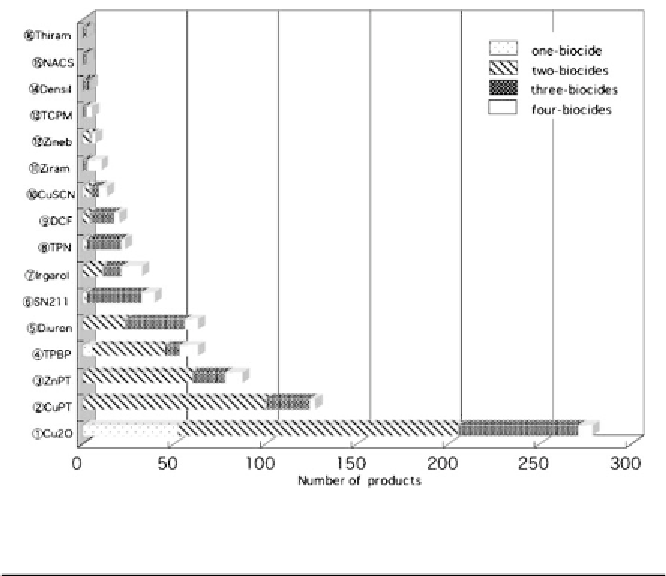Environmental Engineering Reference
In-Depth Information
Fig. 4
Combinations of biocides in antifouling paint products
Table 4
Combinations of two-biocides with the number of products for each type
Cu
2
O+CuPT:99
ZnPT+TPBP:36
Cu
2
O+ZnPT:23
Cu
2
O+Diuron:22
TPBP + DCF: 4
TPBP + Irgarol: 4
Cu
2
O + zineb: 4
Cu
2
O + Irgarol: 3
TPN + Diuron: 1
Cu
2
O+CuSCN:1
Cu
2
O + SN211: 1
CuPT + CuSCN: 1
ZnPT + CuSCN: 1
The biocides numbered
1
-
8
are frequently combined in antifouling paint
products (Table 3). The four most frequently combined biocides, Cu
2
O, CuPT,
ZnPT, and TPBP, are used alone or in two-biocide mixtures, with a fre-
quency greater than 50%. Conversely, the other 12 biocides listed in Table 3
are mainly combined in three- or four-biocide mixtures. From these combi-
nations, it can be assumed that the role of the remaining 12 is as a cobiocide
to enhance the antifouling effects of the first four biocides. Cu
2
Oisusedwith
13 cobiocides in 73% of the total products, but it is never used with TPBP, zi-
ram, or thiram. CuPT is always used with Cu
2
O, and is not used alone. CuPT
or ZnPT is used in two-biocide mixtures in most cases. ZnPT and CuPT have
a similar chemical structure with a different central metal in the mother moi-
ety. It has been reported that ZnPT is converted to CuPT when it is combined
with Cu
2
O [5]. There is only one product containing a combination of Cu
2
O,
CuPT, and ZnPT in the List. TPBP is most frequently used in two-biocide mix-
tures with 40 products. It is reported that TPBP cannot be used with Cu
2
O,


